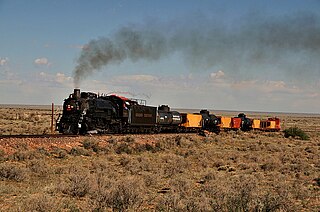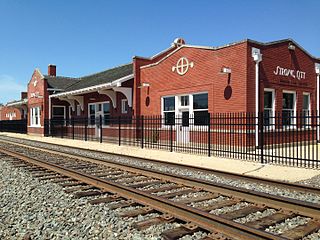
Strong City is a city in Chase County, Kansas, United States. Originally known as Cottonwood Station, in 1881 it was renamed Strong City after William Barstow Strong, then vice-president and general manager, and later president of the Atchison, Topeka and Santa Fe Railway. As of the 2020 census, the population of the city was 386. It is located along U.S. Route 50 highway.

The Grand Canyon Railway is a heritage railroad which carries passengers between Williams, Arizona, and the South Rim of Grand Canyon National Park.

El Paso Union Depot is an Amtrak train station in El Paso, Texas, served by the Texas Eagle and Sunset Limited. The station was designed by architect Daniel Burnham, who also designed Washington D.C. Union Station. It was built between 1905 and 1906 and was added to the National Register of Historic Places in 1971.

Norman station is an Amtrak intercity rail station in Norman, Oklahoma, served by the daily Heartland Flyer. Built in 1909, the station building was added to the National Register of Historic Places in 1991 as Santa Fe Depot. Part of the building is occupied by The Depot, a non-profit arts association.

Williams Depot is a privately owned train station in Williams, Arizona. It is the southern terminus of the Grand Canyon Railway line.

Claremont is a passenger rail and bus station in Claremont, California, United States. It is served by Metrolink's San Bernardino Line which runs from Los Angeles Union Station to San Bernardino-Downtown, with some trains formerly continuing to Riverside on weekends. The Mission Revival-Spanish Colonial Revival style station is listed on the U.S. National Register of Historic Places as Atchison, Topeka and Santa Fe Railroad Station.

The Fullerton Transportation Center is a passenger rail and bus station located in Fullerton, California, United States.

The San Bernardino Santa Fe Depot is a Mission Revival Style passenger rail terminal in San Bernardino, California, United States. It has been the primary station for the city, serving Amtrak today, and the Santa Fe and Union Pacific Railroads in the past. Until the mid-20th century, the Southern Pacific Railroad had a station 3/4 of a mile away. It currently serves one Amtrak and two Metrolink lines. The depot is a historical landmark listed on the National Register of Historic Places as Atchison, Topeka and Santa Fe Railway Passenger and Freight Depot.

The Atchison, Topeka and Santa Fe Passenger and Freight Complex is a nationally recognized historic district located in Fort Madison, Iowa, United States. It was listed on the National Register of Historic Places in 1992. At the time of its nomination it contained three resources, all of which are contributing buildings. The buildings were constructed over a 24-year time period, and reflect the styles that were popular when they were built. The facility currently houses a local history museum, and after renovations a portion of it was converted back to a passenger train depot for Amtrak, which opened on December 15, 2021.

Atchison, Topeka and Santa Fe Passenger Depot or Santa Fe Station in Colorado Springs, Colorado is a historic railway station. The grand depot and Harvey House was built in 1917 as a joint Santa Fe/Colorado and Southern Railway facility. In 1972, the Santa Fe tracks through Colorado Springs were removed and rail operations were consolidated on the former Rio Grande trackage on the west side of town. The depot and the nearby express building now serves as Catalyst Campus for Technology and Innovation.
Atchison, Topeka and Santa Fe Railway Depot, or variations with Railroad or Station or Passenger and/or Freight may refer to any one of many stations of the Atchison, Topeka and Santa Fe Railway. These include:

Gulf, Colorado and Santa Fe Railroad Passenger Station is located on 1501 Jones Street in Fort Worth, Texas. The depot was built by the Gulf, Colorado and Santa Fe Railroad in 1900 and renovated in 1938. It was originally called the Fort Worth Union Depot. Other tenant railroads at the station were the Chicago, Rock Island and Gulf Railway, the St. Louis–San Francisco Railway ('Frisco') and the Southern Pacific Railroad.

Great Overland Station, listed on the National Register of Historic Places as Union Pacific Railroad Passenger Depot, is a museum and former railroad station in Topeka, Kansas, United States. The station was built from 1925 to 27 and designed by Gilbert Stanley Underwood, whose firm designed over 20 Union Pacific Railroad stations from 1924 to 1931. The station's Free Classical Revival design uses terra cotta extensively and features a center pavilion with two increasingly smaller pavilions on either side. Passenger service to the station began in January 1927; almost 20,000 people attended the station's grand opening, and the new station was considered "one of the largest and finest stations west of the Missouri River". In the later years of its train station life, it also hosted the passenger trains of the Chicago, Rock Island and Pacific Railroad. The Atchison, Topeka and Santa Fe Railway 'Santa Fe' had its trains stop at its own Topeka station.

The Santa Fe Passenger and Freight Depot is a former Santa Fe Railroad station located at 150 Central Valley Highway in Shafter, in the southern San Joaquin Valley within Kern County, California.
Edward Alfred Harrison, known as E. A. Harrison, was an American architect who worked as a staff architect for the Atchison, Topeka & Santa Fe Railway, with offices in Topeka, Kansas, and later in Chicago, Illinois.
The Waynoka Santa Fe Depot and Harvey House in Waynoka, Oklahoma are substantial brick buildings from 1910 built for the Atchison, Topeka and Santa Fe Railway. The Harvey House operated from 1910 to 1937, and was renovated to serve as a dormitory and reading room for train crewmen. The Depot was a stop for the San Francisco Chief. It was listed on the National Register of Historic Places listings in Woods County, Oklahoma in 1974.

The Atchison, Topeka, and Santa Fe Railroad Depot in Los Lunas, New Mexico was built in 1879. It was listed on the National Register of Historic Places in 1979.

The Atchison, Topeka and Santa Fe Railway Depot in Magdalena, New Mexico was listed on the National Register of Historic Places in 1978.

The Boone Santa Fe Railroad Depot, at 100 Baker Ave. in Boone, Colorado, was listed on the National Register of Historic Places in 1997.

The Strong City Atchison, Topeka & Santa Fe Depot is a historic railway station at 102 W. Topeka Avenue in Strong City, Kansas. The station was built by the Atchison, Topeka and Santa Fe Railway (ATSF) in 1913 to replace the city's previous station. The ATSF first built a line through the city in 1872, bypassing the county seat of Cottonwood Falls. To honor the railroad, the city changed its name from Cottonwood Station to Strong City in 1881 for ATSF vice president William Barstow Strong. Strong City's first railroad station was a simple wood building, and after a 1902 fire the town replaced it with a board-and-batten structure. In the early 1910s, the ATSF began replacing the stations in its most important stops with permanent brick buildings; the new stations were known as county-seat depots, as they typically served a county seat or the most important station in a county. The Strong City depot is typical of the ATSF's corporate architecture at the time and includes elements of the American Craftsman and Mission Revival styles. It served passenger trains until the late 1940s and continued to function as a railway office for many years afterward.



















